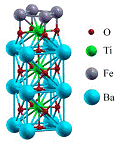Department of Physics and Astronomy: Publications and Other Research

Evgeny Tsymbal Publications
ORCID IDs
Tsymbal http://orcid.org/0000-0002-6728-5496
Document Type
Article
Date of this Version
5-2000
Citation
Journal of Applied Physics (2000) 87: 5,230-5,232
Abstract
Bonding at the ferromagnet–insulator interface is an important factor which influences spin polarization of the tunneling current in ferromagnetic tunnel junctions. In this article we investigate the spin-polarized electronic structure of the (001) surface of body-centered-cubic iron covered by an oxygen overlayer, as this could reflect the mechanism of bonding and spin polarization in iron/oxide tunnel junctions. The Fe/O atomic structure is optimized using the plane-wave code CASTEP within the spin-polarized generalized-gradient approximation. The electronic structure and local densities of states are calculated using the linear muffin-tin orbital method. The results show hybridization of the iron 3d orbitals with the oxygen 2p orbitals, the strong exchange splitting of the former resulting in exchange-split bonding and antibonding oxygen states. These antibonding states are partially occupied for the majority spins but are almost unoccupied for the minority spins, which leads to a positive spin polarization in the density of states of the oxygen atoms at the Fermi energy. This positive spin polarization propagates from oxygen into the vacuum barrier. This is opposite to what is observed for clean Fe films, where the surface Fe layer has a negative spin polarization at the Fermi energy and remains negative into the vacuum. We infer that this p – d bonding mechanism might be responsible for the experimentally observed positive spin polarization of the tunneling current from ferromagnetic metals through alumina.


Comments
Copyright © 2000, American Institute of Physics. Used by permission